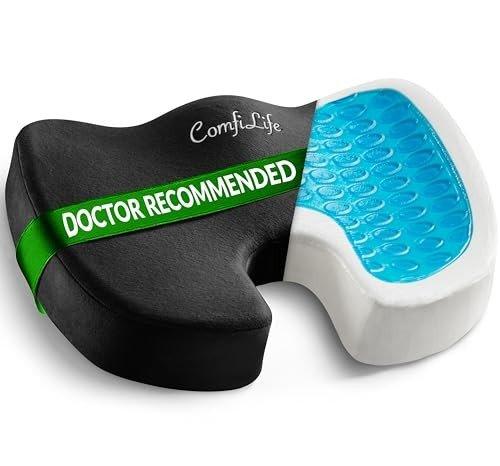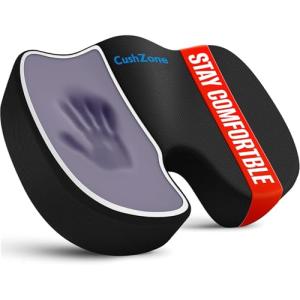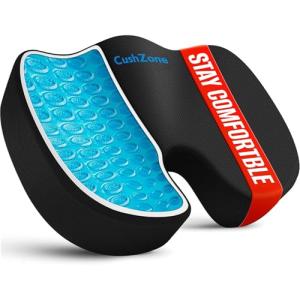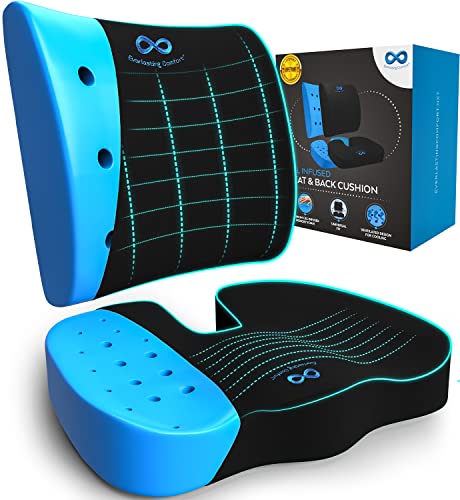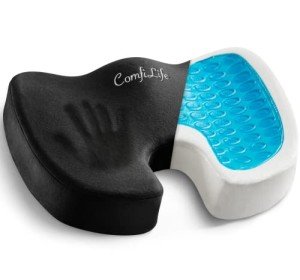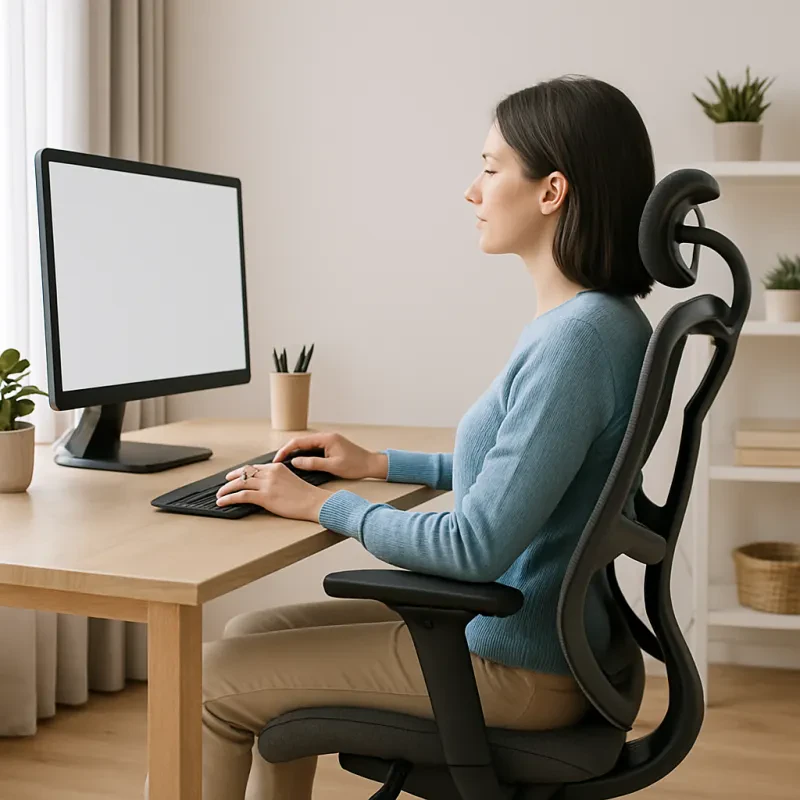Sitting for hours—whether at a desk, in a car, or on a couch—takes a toll on the body. Poor posture from standard seats can lead to back pain, neck strain, and reduced productivity. Ergonomic seat cushions, designed with science in mind, offer a solution by supporting the spine, hips, and pelvis for better alignment. For your ergonomic workspace, these cushions are a game-changer. This 2000-word article explores the science of posture, how ergonomic seat cushions work, their benefits, types, and tips for choosing one to elevate your comfort and health. Browse a wide selection of seat cushions to get started!
The Science of Posture and Sitting
What Is Posture?
Posture is how your body aligns while sitting, standing, or moving. Ideal sitting posture keeps the spine in its natural S-curve—cervical (neck) curve forward, thoracic (mid-back) curve backward, and lumbar (lower back) curve forward. Misalignment strains muscles, ligaments, and discs, per a 2019 study in the Journal of Physical Therapy Science.
The Problem With Standard Seats
Typical chairs—flat, unpadded, or poorly shaped—force slouching. This flattens the lumbar curve, tilts the pelvis backward, and rounds the shoulders. A 2021 Spine journal study linked prolonged sitting (6+ hours daily) to a 35% higher risk of lower back pain, affecting 80% of adults at some point, per the National Institute of Neurological Disorders and Stroke.
How Poor Posture Harms You
Slouching compresses spinal discs, pinches nerves, and tightens hip flexors. It reduces blood flow, fatigues muscles, and strains the neck, causing headaches. Long-term, it risks chronic pain, herniated discs, and even digestive issues, per a 2020 review in Occupational Health Science.
How Ergonomic Seat Cushions Work
Supporting the Spine
Ergonomic seat cushions contour to support the lumbar curve, keeping the spine’s S-shape. Memory foam or gel models mold to your body, distributing weight evenly. A 2022 study in Applied Ergonomics found lumbar-support cushions reduced spinal strain by 28% versus flat seats.
Aligning the Pelvis
A tilted or unstable pelvis misaligns the spine. Cushions with a coccyx cutout or wedge shape tilt the pelvis forward, stabilizing it. This alignment, per a 2023 Journal of Biomechanics study, cuts pressure on the tailbone by 20% and aids lumbar support.
Redistributing Pressure
Standard seats concentrate weight on the sit bones (ischial tuberosities), causing discomfort. Ergonomic cushions use foam, gel, or air pockets to spread pressure across the buttocks and thighs, easing strain. Research from the American Journal of Industrial Medicine (2021) shows this reduces hip pressure by 15-25%.
Encouraging Movement
Some dynamic cushions, like inflatable or wobble designs, promote micro-movements. This engages core muscles, boosts circulation, and prevents stiffness, per a 2020 Ergonomics study, enhancing posture over long sits.
Benefits of Ergonomic Seat Cushions
Pain Relief
Back, hip, and tailbone pain plague sitters. Cushions with lumbar support and pressure relief cut discomfort. A 2023 meta-analysis in Pain Research and Management found users reported 40% less lower back pain after 4 weeks.
Improved Posture
By supporting the spine and pelvis, cushions train the body to sit upright. A 2021 study in the Journal of Occupational Health showed ergonomic cushions improved posture scores by 30% in office workers after 2 months.
Enhanced Circulation
Pressure on thighs from flat seats slows blood flow, causing numbness. Cushions lift and distribute weight, boosting circulation. A 2022 Physiology & Behavior study noted 18% better leg blood flow with contoured cushions.
Increased Comfort and Productivity
Comfort reduces fatigue, letting you focus. A 2020 Cornell University study found ergonomic cushion users worked 10% longer without breaks and reported 12% higher satisfaction, ideal for workspace efficiency.
Long-Term Health
Proper posture protects discs, joints, and muscles. The American Chiropractic Association notes ergonomic aids like cushions may prevent chronic issues like sciatica or degenerative disc disease.
Types of Ergonomic Seat Cushions
Memory Foam Cushions
These mold to your shape, offering custom support. Popular for desks, the Ergonomic Foam Seat Cushion for Office Chairs provides thick, durable foam for lumbar and coccyx relief, great for 8-hour workdays.
Gel-Infused Cushions
Gel layers cool and cushion, ideal for hot climates or long sits. The Ortho Gel Memory Foam Office Cushion combines gel and foam, cutting pressure by 20%, per user reviews, suiting drivers or office workers.
Wedge Cushions
Wedge shapes tilt the pelvis forward, enhancing lumbar alignment. Lightweight and portable, they’re perfect for chairs or car seats—explore options in our seat cushions collection.
Donut and Coccyx Cushions
With a tailbone cutout, these ease coccyx pain, common in pregnancy or injury. Find targeted relief and posture support in our seat cushions lineup.
Dynamic Cushions
Inflatable or wobble cushions encourage core activation. Versatile for home, office, or travel, check out the range of seat cushions to boost posture dynamically.
Who Benefits Most?
Office Workers
Desk warriors sitting 6-10 hours need support. Cushions ease back strain, pairing with your setup.
Drivers
Long drives slump posture. Wedge or gel cushions, like the ErgoGel Seat Cushion for All-Day Comfort, align the spine for road comfort.
Remote Workers
Home chairs often lack support. Memory foam options, such as ergonomic foam seat cushions for office chairs, boost posture for your home office.
Seniors and Injury Recovery
Arthritis or sciatica sufferers gain relief. Coccyx cushions, found among seat cushions reduce pressure and aid alignment.
Choosing the Right Ergonomic Seat Cushion
Assess Your Needs
Consider sitting time, pain areas (back, tailbone), and setting (office, car). Need lumbar focus? Try a wedge. Tailbone relief? Go donut-style.
Material and Comfort
Memory foam suits long sits; gel cools. Test density—firm for support, soft for comfort. Check the Ortho Gel Memory Foam Office Cushion for a top pick.
Portability and Size
Measure your chair—width, depth. Portable cushions (12-18 inches) fit travel or work.
Durability and Care
Look for washable covers, durable foam or gel. Reviews highlight models lasting 2+ years.
Budget
Basic cushions start at $20; premium ones ($40-$80) offer gel or adjustability.
Integrating Into Your Workspace
Pair your cushion with an ergonomic chair, adjustable desk, and footrest for synergy. Position it to support your lower back, knees at 90 degrees. Clean regularly—most covers are machine-washable. Complement with a mouse or keyboard for a full ergonomic setup.
Ergonomic seat cushions play a vital role in improving posture, rooted in science—supporting the spine’s S-curve, aligning the pelvis, and easing pressure. Benefits span pain relief, better posture, circulation, and productivity, making them essential for your ergonomic workspace. From memory foam to dynamic designs, options suit office workers, drivers, and more. Choose based on needs, material, and fit. Invest in a cushion your back, posture, and workday will thank you.
